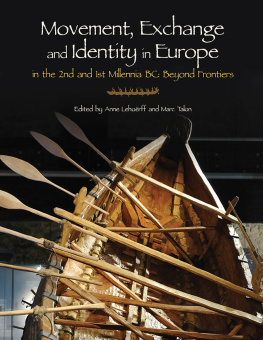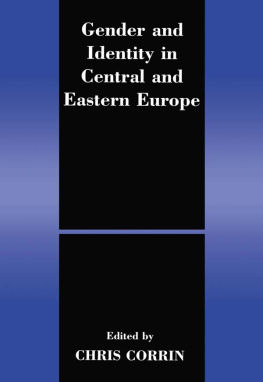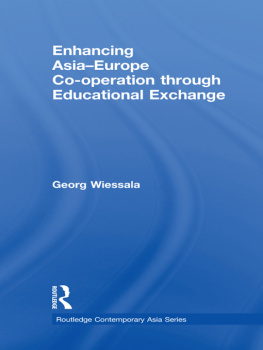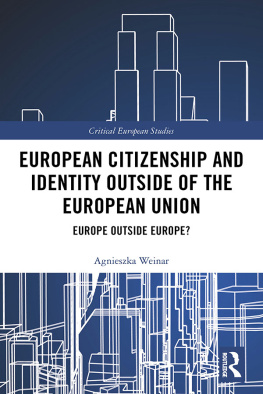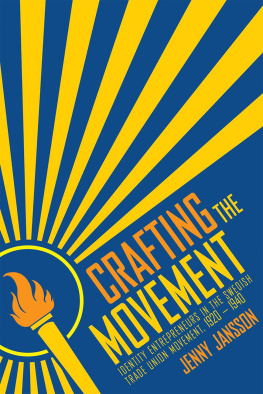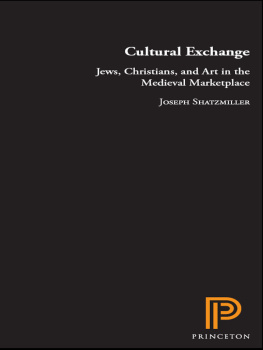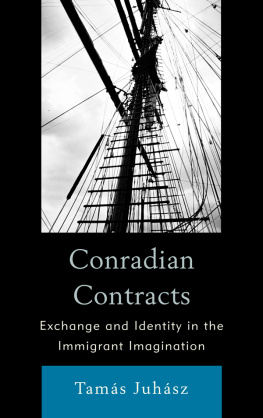Lehoërff - Movement, Exchange and Identity in Europe in the 2nd and 1st Millennia BC
Here you can read online Lehoërff - Movement, Exchange and Identity in Europe in the 2nd and 1st Millennia BC full text of the book (entire story) in english for free. Download pdf and epub, get meaning, cover and reviews about this ebook. year: 2017, publisher: Casemate Publishers & Book Distributors, LLC, genre: Art. Description of the work, (preface) as well as reviews are available. Best literature library LitArk.com created for fans of good reading and offers a wide selection of genres:
Romance novel
Science fiction
Adventure
Detective
Science
History
Home and family
Prose
Art
Politics
Computer
Non-fiction
Religion
Business
Children
Humor
Choose a favorite category and find really read worthwhile books. Enjoy immersion in the world of imagination, feel the emotions of the characters or learn something new for yourself, make an fascinating discovery.
Movement, Exchange and Identity in Europe in the 2nd and 1st Millennia BC: summary, description and annotation
We offer to read an annotation, description, summary or preface (depends on what the author of the book "Movement, Exchange and Identity in Europe in the 2nd and 1st Millennia BC" wrote himself). If you haven't found the necessary information about the book — write in the comments, we will try to find it.
Lehoërff: author's other books
Who wrote Movement, Exchange and Identity in Europe in the 2nd and 1st Millennia BC? Find out the surname, the name of the author of the book and a list of all author's works by series.
Movement, Exchange and Identity in Europe in the 2nd and 1st Millennia BC — read online for free the complete book (whole text) full work
Below is the text of the book, divided by pages. System saving the place of the last page read, allows you to conveniently read the book "Movement, Exchange and Identity in Europe in the 2nd and 1st Millennia BC" online for free, without having to search again every time where you left off. Put a bookmark, and you can go to the page where you finished reading at any time.
Font size:
Interval:
Bookmark:


Published in the United Kingdom in 2017 by
OXBOW BOOKS
The Old Music Hall, 106108 Cowley Road, Oxford OX4 1JE
and in the United States by
OXBOW BOOKS
1950 Lawrence Road, Havertown, PA 19083
Oxbow Books and the individual authors 2017
Hardback Edition: ISBN 978-1-78570-716-2 (hardback)
Digital Edition: ISBN 978-1-78570-717-9 (epub)
A CIP record for this book is available from the British Library and the Library of Congress
All rights reserved. No part of this book may be reproduced or transmitted in any form or by any means, electronic or mechanical including photocopying, recording or by any information storage and retrieval system, without permission from the publisher in writing.
Printed in Malta by Melita Press
Typeset in India by Lapiz Digital Services, Chennai
For a complete list of Oxbow titles, please contact:
UNITED KINGDOM
Oxbow Books
Telephone (01865) 241249, Fax (01865) 794449
Email:
www.oxbowbooks.com
UNITED STATES OF AMERICA
Oxbow Books
Telephone (800) 791-9354, Fax (610) 853-9146
Email:
www.casemateacademic.com/oxbow
Oxbow Books is part of the Casemate Group
Front cover: Anne Lehorff for BOAT 1550 BC.
| Anne Lehorff |
| Guy De Mulder and Jean Bourgeois |
| Walter Leclercq and Eugne Warmenbol |
| Stuart Needham |
| Steven Matthews |
| Cyril Marcigny, Jean Bourgeois et Marc Talon |
| Pierre-Yves Milcent |
| Peter Clark |
| Nathalie Buchez, Yann Lorin, Emmanuelle Leroy-Langelin, Armelle Masse, Anglique Sergent and Sbastien Toron with the collaboration of J. Brenot, K. Fechner, . Lecher, E. Martial and Y. Petite |
| Ghislaine Billand, Isabelle Le Goff and Marc Talon |
| Rgis Issenmann, Capucine Tranchant, Alexis Corrochano et milie Dubreucq |
| Emmanuelle Leroy-Langelin, Yann Lorin, Armelle Masse, Anglique Sergent and Marc Talon |
| Nathalie Buchez, Marianne Deckers, Caroline Gutierrez, Alain Henton et Marc Talon |
| Sbastien Manem |
| Alain Henton et Nathalie Buchez |
| Patrice Brun |
| Christoph Huth |
| Mireille David-Elbiali |
The political vocabulary of Europe in the early part of the 21st century has resonated with themes of boundary and difference, of boundaries between states, concepts of them and us, a concern to resist change, to maintain the status quo . The concerns of today do not reflect the nature of the long sweep of European history, however. Archaeologists and historians have long known about the ebb and flow of people as they moved across the continent over the millennia, of the ever-changing and porous borders between groups of people, the exchange of goods, ideas and the evolution of identities over time.
More particularly, the integration of professional archaeological research into the planning legislation of many European countries since the Valetta Convention for the Protection of the Archaeological Heritage of Europe in 1992 has resulted in an explosion of new knowledge about our European ancestors and the way they lived their lives. It was the recognition of the implications of this new data for the close maritime connections between peoples living in the Transmanche zone of northwestern Europe during the Bronze Age around 3500 years ago that led to the creation of the European project Boat 1550 BC project in 2011. The project sought to bring together this new evidence of the strong ancient cultural links between the peoples of the region and present it to a wider audience. It brought together seven partners from three countries: the University of Lille 3/Maison europenne de lhomme et de la socit de Lille, the Institut National de Recherches Archologiques Preventives (INRAP), the Dpartement du Pas-de-Calais and the town of Boulogne-sur-Mer from France, the Canterbury Archaeological Trust and Canterbury Christ Church University from England, and Ghent University from Belgium. It was financially supported by the European Union Interreg IV A 2 Mers Seas Zeen programme and the Conseil rgional du Nord-Pas-de-Calais.
It was in the context of the Boat 1550 BC project that a major academic conference was planned in collaboration with APRAB (lAssociation pour la Promotion des Recherches Archologiques sur lge du Bronze) that brought together academic and professional archaeologists from all over Europe (and beyond) to discuss the new discoveries and research into the connections between people in the past. Its remit went beyond the study of the Transmanche zone and indeed the Bronze Age, but instead extended right across Europe, reflecting on a period of two millennia, from the middle of the 3rd millenium BC to the middle of the 1st millenium BC. The conference was held on 35 October 2012 at the Universit du Littoral in the beautiful historic town of Boulogne-sur-Mer, France.
The proceedings of the conference are a co-production of Oxbow Books and APRAB, with the financial support of the Ministre de la Culture et de la communication, INRAP, and the UMR (Unit Mixte de Recherche) 8164 Halma.
The conference organisers would like to thank The Universit du Littoral, the Centre de la Mer Nausicaa, and the service archologique de la Ville de Boulogne for their assistance and the warm welcome extended to this international symposium.
Thanks should also go to the conference steering committee for their work in making the conference a success; Sylvie Boulud, Peter Clark, Alain Henton, Isabelle Kerouanton, Thibault Lachenal, Emmanuelle Leroy-Langelin, Armelle Masse, Claude Mordant, Pierre-Yves Milcent, Thophane Nicolas, Brendan OConnor and Rebecca Peake.
Peter Clark, Mark Duncan and Jane Elder of the Canterbury Archaeological Trust are also acknowledged for their help in bringing this volume to publication.
Taken together, these varied contributions offer a new and different perspective on the relationships between the peoples of Europe in the distant past, a perspective that we hope will find a wide audience and help inform all about the prehistoric context of our modern world and our appreciation of European identity today.
Lastly, we pause to remember and celebrate the lives of two outstanding scholars of European prehistory who have recently passed away; Richard Darrah, perhaps best known for his ground-breaking work on the Dover Bronze Age boat, and Colin Burgess, whose magisterial command of the European Bronze Age inspired generations of archaeologists. We hope this volume represents a modest tribute to their outstanding contribution to our knowledge of Europes ancient history.
Anne Lehorff
There are three kinds of men: the living, the dead and those who sail the sea
Quote attributed to: Aristote, Plato or Anacharsis
Keywords: mobility, exchange, frontiers, Bronze Age, identities
The Europe of ancient oral societies, before Classical Antiquity, is sometimes perceived as a closed world, stable immobile even. This widespread perception, inherited from 19th century historiography and nourished by classical texts such as the Gallic War by Julius Caesar, seeks to limit the people of these bygone times to their birth places, when not conjuring up an image of their all too miserable way of life. However, nothing is less true than the idea of static communities over the millennia of Protohistory, from the Neolithic to the end of the Metal Ages (Lehorff 2009; 2011).
Next pageFont size:
Interval:
Bookmark:
Similar books «Movement, Exchange and Identity in Europe in the 2nd and 1st Millennia BC»
Look at similar books to Movement, Exchange and Identity in Europe in the 2nd and 1st Millennia BC. We have selected literature similar in name and meaning in the hope of providing readers with more options to find new, interesting, not yet read works.
Discussion, reviews of the book Movement, Exchange and Identity in Europe in the 2nd and 1st Millennia BC and just readers' own opinions. Leave your comments, write what you think about the work, its meaning or the main characters. Specify what exactly you liked and what you didn't like, and why you think so.

